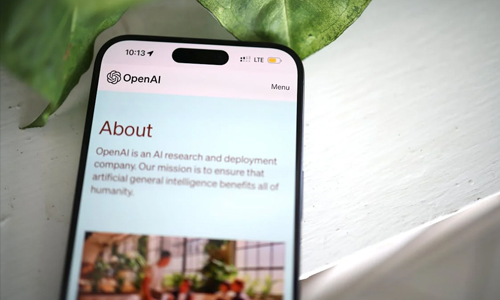A More Direct ChatGPT: A Step Towards Natural Conversation?

AI & ML
What Does the Update Entail?
 Previously, ChatGPT was known for its elaborative and sometimes verbose responses. While informative, this style could feel less natural in casual conversation. The new update addresses this by focusing on:
Previously, ChatGPT was known for its elaborative and sometimes verbose responses. While informative, this style could feel less natural in casual conversation. The new update addresses this by focusing on:
Conciseness
ChatGPT will strive to deliver information in a more streamlined manner, avoiding unnecessary repetition or overly complex sentence structures. For instance, instead of saying “In conclusion, it can be observed that the weather forecast for tomorrow is predicted to be sunny with a slight chance of afternoon showers,” the updated model might say, “Sunny tomorrow with a chance of afternoon showers.”Directness
Responses will aim to directly address the user’s query or prompt, focusing on the core message. If a user asks, “What are some good restaurants near me?” The updated ChatGPT might provide a list of nearby restaurants with brief descriptions instead of launching into a lengthy explanation of different cuisines.Conversational Language
The update incorporates a more informal and natural flow of language, mimicking the way humans interact in everyday conversation. This might involve using contractions, employing humor or sarcasm where appropriate, and adapting the tone based on the context of the conversation. These changes are achieved through improvements to the underlying GPT-4 Turbo model that powers ChatGPT. The upgraded model is trained on a more extensive dataset of text and code, allowing it to better grasp conversational nuances and generate responses that feel more human-like. Here, it’s important to note the ongoing debate around training data bias. As with any AI model, the quality and diversity of the training data will significantly impact the model’s outputs. OpenAI will need to ensure their datasets are comprehensive and unbiased to avoid perpetuating stereotypes or misinformation through ChatGPT’s responses.Who Benefits from the Update?
 The impact of this update can be felt by various users:
The impact of this update can be felt by various users:
Casual Users
Those seeking quick answers or engaging in informal chats with ChatGPT will likely find the experience more engaging and efficient due to the model’s conciseness and conversational style. Imagine having a quick back-and-forth with ChatGPT about the latest movie releases or getting a concise summary of a complex news story.Businesses
Companies utilizing ChatGPT for customer service applications can benefit from clearer and more direct communication, potentially leading to improved customer satisfaction. A customer inquiring about a product might receive a clear and concise explanation of its features and benefits instead of a lengthy, technical response that could leave them confused.Developers
The update can enhance the usability of ChatGPT as a development tool, allowing for more focused and streamlined interactions during the creation of AI-powered applications. Developers might use ChatGPT to brainstorm ideas, generate code snippets, or test different functionalities in a more natural and efficient way.The Potential Impact on Writer-AI Differentiation
One interesting implication of the update is the potential impact on the ability of writers to differentiate themselves from AI-generated content. As ChatGPT’s responses become more concise, informative, and grammatically correct, it might become increasingly challenging for some human writers to compete on those aspects alone. However, human writers still possess several advantages:Creativity and Originality
AI models, by their nature, are trained on existing data. Human writers can bring fresh perspectives, unique storytelling abilities, and the power of independent thought to their work.Emotional Connection
Human writers can evoke emotions and connect with readers on a deeper level through their writing style, voice, and personal experiences. AI, while capable of mimicking some emotional language, may struggle to replicate genuine human sentiment.Critical Thinking and Analysis
AI models can generate factual information but may struggle with critical thinking and in-depth analysis. Human writers can analyze complex topics, identify nuances, and present well-reasoned arguments, adding depth and credibility to their work.The Future of AI Communication
OpenAI’s update to ChatGPT signifies a crucial step forward in fostering more natural and user-friendly AI interactions. As AI technology continues to evolve, we can expect further advancements in areas like:Contextual Understanding
AI models that can better grasp the context of a conversation and respond accordingly. Imagine a future where AI assistants can understand the emotional tone of a user’s voice and tailor their responses to be supportive or empathetic.Emotional Intelligence
The ability of AI to recognize and respond to human emotions, creating more empathetic interactions. This could revolutionize fields like customer service or mental health support, where emotional intelligence plays a crucial role.Explainability
Developing AI models that can explain their reasoning and decision-making processes, fostering trust and transparency. This would be particularly important in situations where AI makes critical judgments or recommendations. While the complete indistinguishability of AI from humans may still be some time away, advancements like the recent ChatGPT update pave the way for a future where AI communication seamlessly integrates into our daily lives. Whether it’s seeking quick information, engaging in casual conversation, or even collaborating on creative projects, AI assistants like the improved ChatGPT hold immense potential to reshape the way we interact with technology. However, it’s crucial to remember that AI is a tool, and like any tool, its impact depends on how we use it. OpenAI’s focus on making ChatGPT’s responses more direct and concise is a positive step towards fostering clear and efficient communication. As AI technology continues to evolve, it’s our responsibility to ensure its development is ethical, responsible, and ultimately beneficial for humanity. Also Read: https://www.technogala.com/the-ai-arena-claude-3-vs-chatgpt-a-comparative-analysis/You Might Be Interested In:
- Beyond Likes and Followers: Exploring the Evolving Landscape of Social Media
- Is TikTok Facing a US Ban? Decoding the New Law and Its Impact on Millions of Users
- Click, Buy, Pollute? Environmental Impact of Online Shopping and Ways for Sustainable E-commerce
- The High Price of Crypto: Environmental Cost of Mining and Solutions for a Greener Future
Frequently Asked Questions?

01
Cybersecurity
Beyond Likes and Followers: Exploring the Evolving Landscape of Social Media
Apr 28, 2024
01
Tech news
Is TikTok Facing a US Ban? Decoding the New Law and Its Impact on Millions of Users
Apr 27, 2024

01
Tech news
Click, Buy, Pollute? Environmental Impact of Online Shopping and Ways for Sustainable E-commerce
Apr 26, 2024

01
AI & ML
Gemini Evolves: Your AI Assistant on the Go with the New Overlay Feature
Apr 24, 2024
SUSBSCRIBE TO OUR NEWSLETTER
Join our subscribers list to get the latest news and special offers.
Beyond Likes and Followers: Exploring the Evolving Landscape of Social Media
Is TikTok Facing a US Ban? Decoding the New Law and Its Impact on Millions of Users
Click, Buy, Pollute? Environmental Impact of Online Shopping and Ways for Sustainable E-commerce
The High Price of Crypto: Environmental Cost of Mining and Solutions for a Greener Future